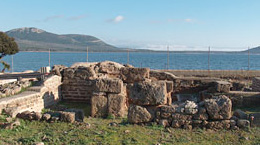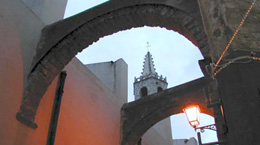Palmavera nuragic village
The nuragic complex, above in the picture, is visible even from the street which in Alghero conducts to Porto Conte.
The entry is located at the intersection to the Lazzaretto beach.
Its name is because of the hill where the complex appeared. From the two central towers the oldest one is made with limestone blocks and the recent one is built with sandstone blocks.
The towers are surrounded by cabanas composed by only one place which was used like rooms. The Meeting cup is interesting from an archaeological point of view. It preserves one of the few Nuragic models where is visible the upper section structure which felt down from other existing nuraghi.
A qualified guide service is available to know more about the history and village's secrets.

Archaeological area of Sant'Imbenia
It is located in the inner part of Porto Conte bay.
This area presents the rest from a nuragic village with huts.
The nuragic complex is characterized by the nuragic rests with an unique tower surrounded by huts and a wide circular hut probably a place for meetings.
This area was worked even by the Phoenicians and there are some Phoenicians interments.
The following era this area was worked by the Romans.
There are visible rests from an ancient Roman colony with an attached necropolis and a maritime house with bathes.
Between the house ruins there are mosaic rests.
Cathedral of Santa Maria
The buildings was started at the beginning of 500 when Alghero became Episcopalian administration.
But many elements make thinking that part from the present ringer tower and the five arches underlying were part from an earlier Islamic building.
The whole structure is the result of many interventions. The most antic part is the octagonal floor campanile meanwhile the Neoclassic façade was added during the 800s.
Under the ring tower there is an wonderful Gothic portal with flower decoration.
